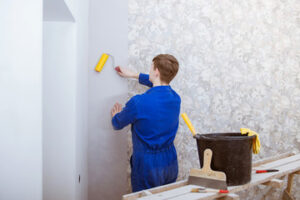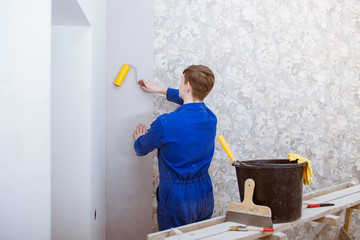Before beginning Wallpaper Installation Seattle make sure the room is level. The wall must be at least 18 inches above the floor. Always measure the length of the wall to determine the proper overlap for your wallpaper. It is best to leave at least two inches of overhang around the ceiling and baseboards. Then, match the pattern to the wall and apply the wallpaper paste. Apply the wallpaper paste evenly to the wall, from center to edge, and then fold the excess wallpaper over each edge. Allow the wallpaper to rest for at least three minutes before you begin the installation.

If you are installing the wallpaper on a wall, be sure to line it up properly so that it won’t lean. The wallpaper needs to be level because walls and ceilings are never 100 percent straight. Before hanging the wallpaper, you must first pull back the paper backing approximately 10 inches. This will allow for proper adhesion. Once this is done, you can smooth the wallpaper using a smoothing cloth. To prevent the wallpaper from buckling, follow the directions on the packaging.
Wallpaper installation is an art and an engineering project. Proper preparation is key to a seamless finish, as it will allow for easy cleaning later on. Also, pay attention to the topography of the room because this can affect the adhesion of the wallpaper. John Dee overlaps the paper at corners when it is not plumb. Decorative papers can range from delicate silks to sturdy types of vinyl and even wood veneer, which looks like solid wood paneling.
Once you have the right measurements, you can begin your wallpaper installation. First, measure the length of the wall and the distance from one end of the strip to the corner. Always make multiple measurements and cut extra paper, if needed. Make sure to add a half-inch extra to the measurements to allow for the corners and other tricky areas. Then cut the wallpaper according to the measurements. Remember to include the width and height of the paper to prevent overlap. In this way, you can avoid wasting time and money on cutting the wrong size.
If you’re renting, you can use removable wallpaper. If you don’t want to damage the walls, you can easily remove the wallpaper, without damaging them. If you live in a house where you will spend a lot of time on the property, you can consider traditional wallpaper. If you’re considering wallpaper for the kitchen or bathroom, vinyl is better than printed wallpaper. If there is no moisture in the room, you should consider printed wallpaper.
Before starting the wallpaper installation, make sure that the power points are turned off. Then, remove the fascia from light switches and plug sockets. After that, you should lay the wallpaper on the wall. If it is a difficult area, you can cut excess wallpaper using a metal ruler or sharp knife. When installing wallpaper, let it dry slowly at room temperature. Avoid letting the wallpaper dry too quickly, as it may shrink. If you’re using wallpaper that covers a light fixture, you should consider hiring a professional to do it.
Before hiring a professional wallpaper installation service, take measurements of the room and walls. The square footage of each wall can help you estimate the cost. Besides the size of the wall, you need to factor in the ceiling height, windows, doors, and closets. Make sure to provide these measurements to the installers, as this helps them estimate the cost for your wallpaper installation. If you haven’t done this yourself, you should consider contacting a home improvement store to find a professional.
The average cost for a roll of wallpaper is approximately $25-$50. One roll of wallpaper covers 30 square feet. The average eight-by-10-foot wall requires about 2.7 rolls. If you’re using vinyl-coated wallpaper, it is much more expensive than coated fabric. However, you can DIY it if you’re not too ambitious. Wallpaper installation is best done by a professional if there are bubbles or creases in the walls.
The cost of professional wallpaper installation depends on the size and complexity of the project. Wallpaper installers generally inspect the wall and determine the exact dimensions before quoting you a price. The cost of an installation can increase significantly depending on factors like the type of wallpaper, the condition of the walls, and the complexity of the installation. Additionally, if you need extensive surface repairs or scaffolding to set up the wallpaper, it can drive up the price of your project. To avoid paying more than you can afford, get multiple quotes. You can also check the references of these wallpaper installers before hiring them.

